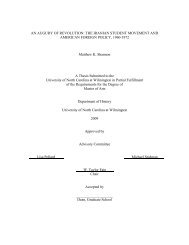Saprolegnia - The iLumina Digital Library
Saprolegnia - The iLumina Digital Library
Saprolegnia - The iLumina Digital Library
Create successful ePaper yourself
Turn your PDF publications into a flip-book with our unique Google optimized e-Paper software.
(see this species) also produce oogonia with imperfectly developed oospores<br />
(Willoughby, 1971a). While the oospores of S. australis are subcentric, those of S. diclina<br />
are predominantly centric. Both species have pitted, generally obpyriform oogonia that,<br />
in S. australis are primarily terminal, but are predominantly lateral in S. diclina. <strong>The</strong>se<br />
two species are thus separable on few characters, and those that may be used show<br />
degrees of variation that encompass features of both. Further study of additional<br />
isolates may show the two to be variants of one species.<br />
Padgett (1978b) demonstrated that <strong>Saprolegnia</strong> australis is capable of actively<br />
invading mesohaline estuarine waters (see Chapter 3). <strong>The</strong> fungus also has been found<br />
associated with fish (Pickering and Willoughby, 1977, on Perca fluviatilis; Hatai, Egusa,<br />
and Nomura, 1977, on fingerlings of rainbow trout); such a habitat further relates<br />
Elliott’s species to S. diclina (which includes S. parasitica sensu Kanouse).<br />
<strong>The</strong> chief experimental work with <strong>Saprolegnia</strong> australis has been that by R. F.<br />
Elliott (1968). She propagated the species under a variety of culture conditions noting<br />
that oospore number and colony and oogonium sizes could be modified. On the other<br />
hand, oospore structure and the origin and degree of branching of the antheridial<br />
filaments were not changed by manipulating the environmental parameters during<br />
incubation. At 25 o C colonies of S. australis produced larger oogonia containing more<br />
oospores than did isolates grown at 20 o C. Larger oogonia, and ones with fewer<br />
oospores, developed on mycelium propagated in larger culture vessels rather than in<br />
smaller ones.<br />
CONFIRMED RECORDS: -- CANADA: Maestres (1977:144, 145, figs. 21-23);<br />
Nolan and Maestres (1978:892, figs. 1, 2). JAPAN: Hatai, Egusa, and Nomura (1977:204,<br />
figs. 6-9). NEW ZEALAND: R. F. Elliott (loc. cit.). UNITED STATES: Padgett<br />
(1976:1260, figs. 1, 2); Shipman (1977: fig. 10).<br />
RECORDED COLLECTIONS: -- BRITISH ISLES: Pickering et al. (1979); Pickering<br />
and Willoughby (1977). CANADA: Maestres and Nolan (1978). UNITED STATES:<br />
Klich (1980); Padgett (1978a); Shipman (1979).<br />
SPECIMENS EXAMINED: -- CANADA (1), NEW ZEALAND (1), R. F. Elliott,<br />
preserved specimens. NORWAY (1), TWJ. UNITED STATES (1), DEP.<br />
<strong>Saprolegnia</strong> hypogyna (Pringsheim) de Bary<br />
Bot. Zeitung (Berlin) 41:56. 1883<br />
(Figure 94 A-D)<br />
<strong>Saprolegnia</strong> ferax var. hypogyna Pringsheim, Jahrb. Wiss. Bot. 9:196, pl. 18, figs. 9, 10.<br />
1873-74.<br />
<strong>Saprolegnia</strong> hypogyna var. I Maurizio, Flora 79:126, pl. 4, figs. 5-12. 1894.<br />
<strong>Saprolegnia</strong> hypogyna var. II. Maurizio, ibid., p. 128, pl. 4, figs. 13-16. 1894.<br />
<strong>Saprolegnia</strong> hypogyna var. III. Maurizio, ibid., p. 129, pl. 4, figs. 17-20a. 1894.<br />
<strong>Saprolegnia</strong> hypogyna var. IV. Maurizio, ibid., p. 131, pl. 4, figs. 21-23. 1894.<br />
<strong>Saprolegnia</strong> hypogyna var. V. Maurizio, ibid., p. 132, pl. 4, figs. 24-27. 1894.<br />
610
















